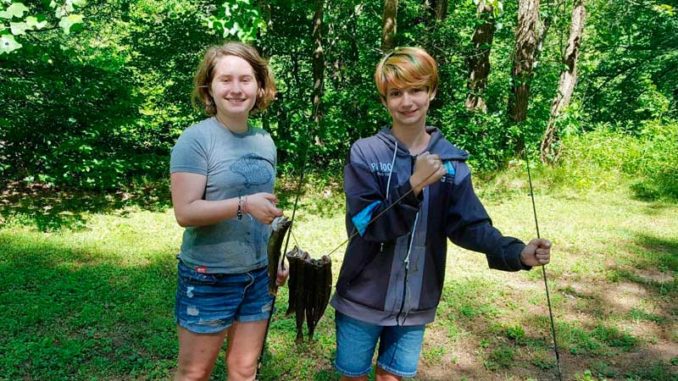
Trout fishing is just as popular as ever
On opening day of the catch-and-keep season on North Carolina’s delayed-harvest streams, kids under age 18 had the streams to themselves. Older ones fished on their own. Parents and grandparents assisted younger ones. And all of them experienced the thrill of hooking and landing trout. It’s an experience that likely will last a lifetime.
The practice began in 2009, when the N.C. Wildlife Resources Commission initiated the youth-only segment of the first Saturday in June. That’s when catch-and-release turns into catch-and-keep on those popular streams. Originally, fishing was limited to kids under 16. But the rules were later amended to allow all kids under 18 to fish.
What better way to introduce youngsters to fishing than to put them on a stream where they are almost guaranteed to catch a limit of trout? And what better way to ensure future generations of avid trout fishers?
This past June 1, scores of youngsters fished the 5-mile section of the Tuckasegee River’s delayed harvest waters. By noon, pull-offs on both segments of the river were crowded with vehicles. Hundreds of adult trout fishers crowded the river, taking their turn on the stream, pulling in trout after trout.
The catch-and-keep season attracts a different type of trout fisher than the ones who dominate the stream during the catch-and-release season. The majority of the catch-and-keep fishers are after food, not sport. They fish with spinning gear and closed-face reels, not top-of-the-line fly rods. They fish with red wigglers, night crawlers, and wax worms. Some even use corn niblets and marshmallows, but not custom-made flies.
Well-established
North Carolina’s delayed-harvest program was implemented on a trial basis in 1992, and included portions of five streams. The catch-and-release season ran from March 1 through the first Friday in June. The program gained wide popularity, and officials added new waters. And in 1996, the catch-and-release portion of the season grew to eight months. The program now has 34 streams and two small lakes in 20 counties. Avery, Buncombe, Cherokee, Rutherford and Stokes are the only western counties without delayed-harvest streams.
South Carolina has portions of five streams designated as delayed-harvest waters. These include the Chattooga River, Chauga River, Cheohee Creek, Devils Fork, Howard Creek and Eastatoee Creek. The South Carolina catch-and-keep seasons runs from May 15 through Oct. 31. Anglers fill their legal creel limit with five trout.
Biologists estimate that approximately 50 percent of stocked trout are caught in the first two weeks of the catch-and-keep season. With the population drastically reduced, the remaining trout have a better chance of surviving the summer. Stream levels drop, water warms and food sources are limited.
Biologists also estimate that a third of stocked trout in delayed-harvest streams disappear during the catch-and-release season. Some die because of improper catching and handling. Others migrate to tributaries. Poachers remove some too.
What are the chances of catching trout in delayed-harvest waters after opening week?
The NCWRC heavily stocked delayed-harvest streams with rainbow, brook and a smaller number of brown trout for the catch-and-release season. Most average 10 inches. But they throw in a few lunker fish for good measure. Most stockings, which are generous, end in June. For example, officials loaded the 5-mile upper section of the Tuckasegee River in Jackson County with approximately 50,000 trout in five stockings. Another 18,000 flooded the lower section in Swain County.
Anglers often easily reach creel limits of seven fish on opening day of the catch-and-keep season. Fishers who get out early often catch their limit in the first hour of fishing. But unfortunately, some take their limits home and return for a second or even a third limit. Wildlife officers monitor the streams on opening day. But violators are difficult to catch unless they’re caught with too many fish in their creels or ice chests. Violators face replacement costs of the fish, fines, court costs, confiscation of fishing gear and loss of fishing privileges.
Keep only supper
Even if the trout need thinning out, no rule says you must take home a limit every time you go fishing. A good rule to follow is keep only what you’ll eat for supper. Too many people catch their limit, go back the next day and catch another limit. They put all those fish in the freezer. And six months later, they remember the trout are in the freezer. And then they throw them out because they’re not worth eating. The only trout worth eating are the ones fresh from the water.
Older people, youngsters, and beginners are especially fond of delayed-harvest streams. The streams provide an excellent environment to learn to fish. Anglers can also try out new fly patterns or lures. And everyone enjoys a pleasant day catching trout.
The beauty of the delayed-harvest fishing program is that fishers of all skill levels get their time on the streams.
Anglers can find stocking schedules, stream locations and maps, and a host of other pertinent information about trout fishing in North and South Carolina via the Internet at www.ncwildlife.org and www.dnr.sc.gov.
Click here and read about camping in close proximity to some stellar trout fishing holes.

